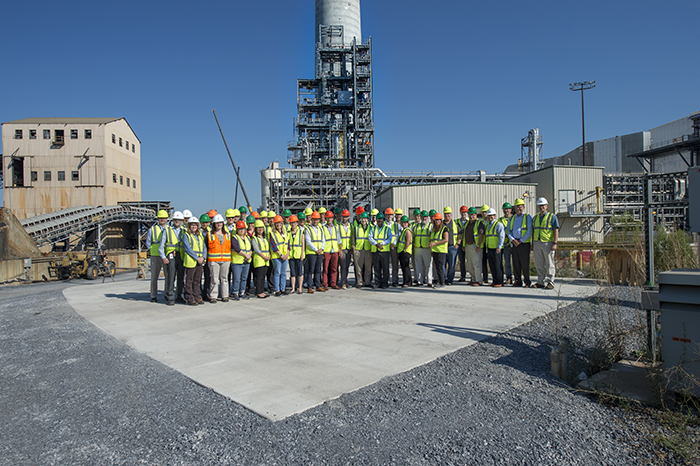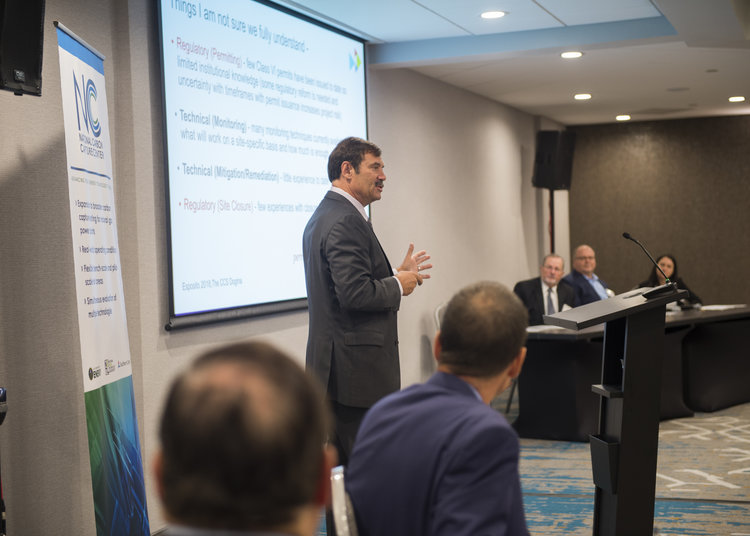The future of carbon capture was the focus at a recent forum of more than 75 carbon capture experts, advocates and developers. Sponsored by Southern Company, the Global CCS Institute and the National Carbon Capture Center, the Bridging the Gap: Carbon Capture Technology Development Forum addressed the opportunities and challenges for carbon capture, use and storage (CCUS) and the need for continued technology research and development.

Bridging the Gap Forum participants enjoy a firsthand look at the National Carbon Capture Center’s work to advance emerging carbon capture technologies. 
Keynote speaker Deputy Assistant Secretary Lou Hrkman describes DOE’s focus on reducing the cost of carbon capture. 
Participants tour the National Carbon Capture Center’s post-combustion carbon capture facility. 
Southern Company’s Richard Esposito outlines the current state of carbon storage initiatives. 
Tour participants explore a technology developer’s test skid. 
National Carbon Capture Center Director John Northington details the facility’s natural gas infrastructure expansion.

Participants take in the scale of post-combustion technology installed at the National Carbon Capture Center.
“Carbon capture is part of our future,” said Steve Wilson, Southern Company research and development general manager, as he welcomed attendees. “It will be required to get to a low- to no-carbon future, while using our nation’s inexpensive and abundant fossil fuels.”
The invitation-only forum in Birmingham, Alabama, brought together national and international carbon capture stakeholders, including technology providers, energy industry and government leaders, as well as interested NGOs. Lou Hrkman, U.S. Department of Energy (DOE) deputy assistant secretary of clean coal and carbon management, presented the keynote address.
“This type of early-stage research and development is essential to our energy future,” Hrkman said, referring to the work of DOE’s National Carbon Capture Center to advance emerging carbon capture technologies for natural gas and coal power plants. “Most of the world has long-term plans for clean coal moving forward. These technologies need to be developed, and they need to be used here in the U.S. and deployed to the rest of the world.”
Hrkman outlined three DOE priorities: increasing performance and competitiveness of America’s existing coal fleet, developing technologies for the future fleet, which includes small-scale, modular coal plants, and reducing the cost of carbon capture.
“This event was conceived to bring together a diverse group of stakeholders to discuss new technology advancements and incentives related to CCUS deployment,” said Richard Esposito, Southern Company R&D geosciences and carbon management program manager.
During the forum, participants discussed the following topics:
- The current state of carbon capture, transportation and storage
- Carbon capture technology showcase
- Capitalizing on the FUTURE Act
- Opportunities and obstacles in the power sector
- Building support for CCUS
- Harnessing international collaboration to advance CCUS
On the second day, participants toured the National Carbon Capture Center, which is managed and operated by Southern Company in nearby Wilsonville, Alabama.
“This firsthand look at a real-world DOE carbon capture test facility provided an excellent overall view of how DOE, the National Carbon Capture Center and others are advancing CCUS solutions,” said Esposito..
Global CCS Institute General Manager Jeff Erikson commented, “This forum provided still more evidence that CCUS is proven, affordable, versatile and essential. The challenge is how to scale up quickly, so that CCUS can achieve its potential to address climate change and provide clean and reliable energy. While both public and private sectors in the U.S. have done much to advance CCUS, there is much more to do.”

